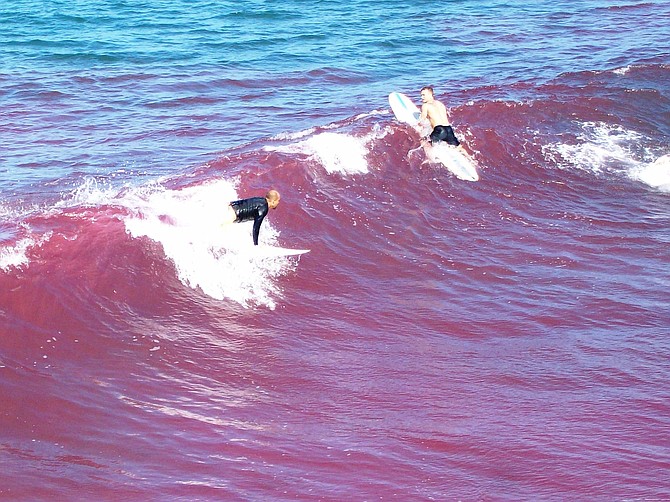 Facebook
Facebook
 X
X
 Instagram
Instagram
 TikTok
TikTok
 Youtube
Youtube

Morning beachgoers in Imperial Beach on September 23rd found surprising colors in the ocean after bright pink tracer dye was released by the Scripps Institution of Oceanography in an experiment to study the movement of water along the coastline.
"There's something wrong," one mother with children was overheard as saying as she approached the shore and saw the pink, red, and magenta colors in the sea. "That's just gross," Tricia Baglioni posted a "purple wave" on Facebook while Elsa Galam Lessner asked, “Is it red tide?"
From his station on the shore, Falk Feddersen, acting professor of Scripps' Integrative Oceanography Division, described the 30 gallons of harmless dye as "like a fake pollution bomb" to be used to understand actual water pollution when it occurs.
Though the test was just starting, Feddersen said they were already getting some surprising results from aerial photos. "We thought it would rocket in a plume up the surf zone up the coast," Feddersen said. "It did that for a while but then the dye just went offshore, and then it decided it wanted to go to Mexico. It basically did a U-turn."
The experiment will help measure the movement of such things as contaminants and larvae in the “nearshore region” where people and ecosystems are affected, according to the Scripps Institution.
By coincidence, the beach was still officially closed to bathers and surfers on the day of the experiment due to possible contamination after the record-breaking rainfall on September 15. Imperial Beach is often closed after rainstorms due to sewage-contaminated runoff from the Tijuana River.
Imperial Beach mayor Serge Dedina said he was concerned that the beach was still closed a full week after the rainstorm, saying that there were indications that the contamination had abated. "We're trying to get the beach open now,” he said, “and we're trying to find out why it’s still closed.”
Feddersen said that even though the dye may not be visible to the eye after a few hours, the Scripps team will be using monitors to continue measuring the movement of the dye until Friday, when all the data will be collected for analysis.
Scripps will do the test again on October 5th during an expected ocean swell in order to test the water exchange patterns under different conditions, Feddersen said.


Morning beachgoers in Imperial Beach on September 23rd found surprising colors in the ocean after bright pink tracer dye was released by the Scripps Institution of Oceanography in an experiment to study the movement of water along the coastline.
"There's something wrong," one mother with children was overheard as saying as she approached the shore and saw the pink, red, and magenta colors in the sea. "That's just gross," Tricia Baglioni posted a "purple wave" on Facebook while Elsa Galam Lessner asked, “Is it red tide?"
From his station on the shore, Falk Feddersen, acting professor of Scripps' Integrative Oceanography Division, described the 30 gallons of harmless dye as "like a fake pollution bomb" to be used to understand actual water pollution when it occurs.
Though the test was just starting, Feddersen said they were already getting some surprising results from aerial photos. "We thought it would rocket in a plume up the surf zone up the coast," Feddersen said. "It did that for a while but then the dye just went offshore, and then it decided it wanted to go to Mexico. It basically did a U-turn."
The experiment will help measure the movement of such things as contaminants and larvae in the “nearshore region” where people and ecosystems are affected, according to the Scripps Institution.
By coincidence, the beach was still officially closed to bathers and surfers on the day of the experiment due to possible contamination after the record-breaking rainfall on September 15. Imperial Beach is often closed after rainstorms due to sewage-contaminated runoff from the Tijuana River.
Imperial Beach mayor Serge Dedina said he was concerned that the beach was still closed a full week after the rainstorm, saying that there were indications that the contamination had abated. "We're trying to get the beach open now,” he said, “and we're trying to find out why it’s still closed.”
Feddersen said that even though the dye may not be visible to the eye after a few hours, the Scripps team will be using monitors to continue measuring the movement of the dye until Friday, when all the data will be collected for analysis.
Scripps will do the test again on October 5th during an expected ocean swell in order to test the water exchange patterns under different conditions, Feddersen said.
Comments